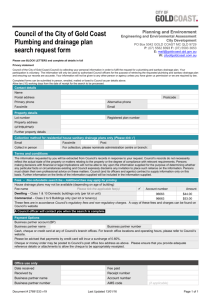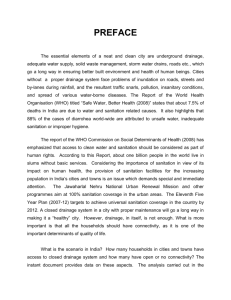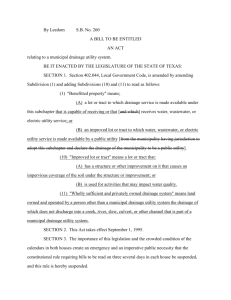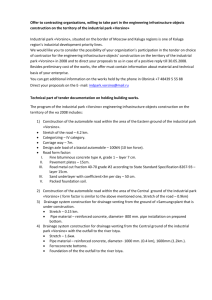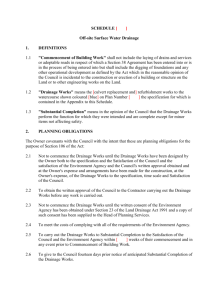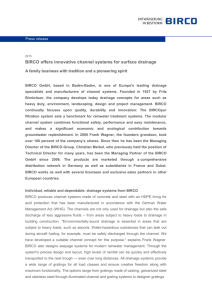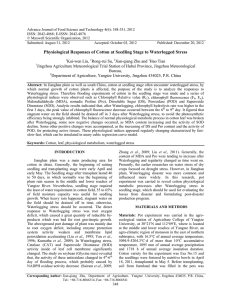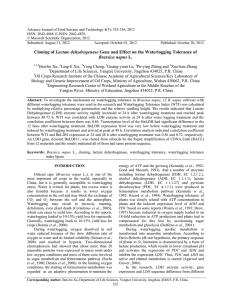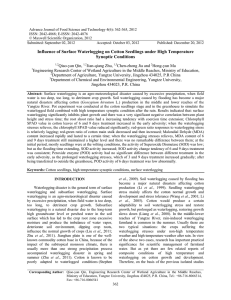Water Quality - Agricultural and Resource Economics
advertisement
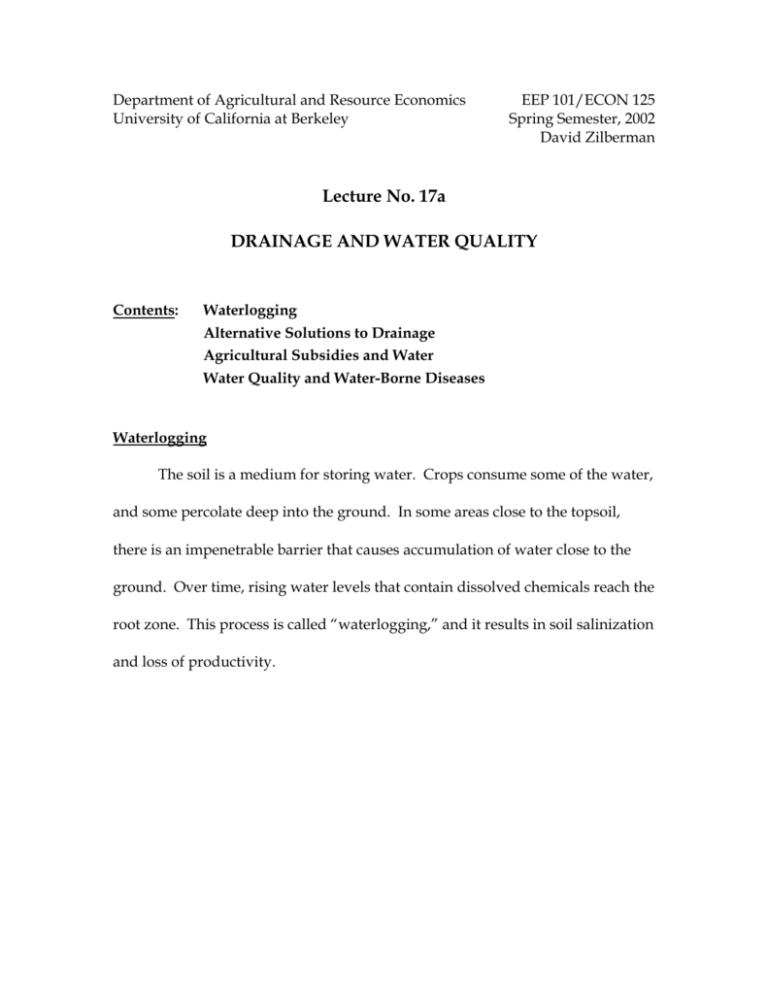
Department of Agricultural and Resource Economics University of California at Berkeley EEP 101/ECON 125 Spring Semester, 2002 David Zilberman Lecture No. 17a DRAINAGE AND WATER QUALITY Contents: Waterlogging Alternative Solutions to Drainage Agricultural Subsidies and Water Water Quality and Water-Borne Diseases Waterlogging The soil is a medium for storing water. Crops consume some of the water, and some percolate deep into the ground. In some areas close to the topsoil, there is an impenetrable barrier that causes accumulation of water close to the ground. Over time, rising water levels that contain dissolved chemicals reach the root zone. This process is called “waterlogging,” and it results in soil salinization and loss of productivity. One solution to the waterlogging problem is construction of tiles that drain groundwater. Water is then conveyed to disposal areas through drainage canals. In Egypt, Pakistan, and other regions, drainage canals convey drainage water to oceans and other areas. Disposing drainage water can be very expensive, particularly when conveyance canals are lengthy. Furthermore, there may be costly environmental damage from disposing drainage water. The West Side of the California Central Valley has a drainage problem that threatens the region’s future. 2 Because of the high cost of drainage canals and problems in disposing drainage water, alternative solutions are being considered. Alternative Solutions to Drainage Waterlogging is a dynamic problem. The water accumulates underneath the soil, and thus there is a problem of stock externalities. The larger the area that percolating water can accumulate, the less severe the problem is. There are several ways to control this problem: (1) Source Reduction This can be done through: a. Fallowing land. b. Adopting modern irrigation technologies to reduce percolation (movement from furrow to drip reduces water application and residues from, say, 40% of applied water to 5%.) c. Switching to crops that consume less water. These solutions can be induced by a tax on water, particularly percolating water. For example, if a farmer uses furrow irrigation and applies 4 acre feet (AF) / acre, and irrigation efficiency is 60%, she will have to pay a tax of X dollars per AF of waterlogging (X times 1.6 AF per acre). Without any drainage, waterlogging is a nonrenewable resource problem, and the tax is equal to the user cost. 3 Difficulty in monitoring water use and especially percolation may lead to alternative incentives including: Subsidy on adoption of modern technologies. Per acre tax based on crop reduction and higher tax on alfalfa than wheat. Limitation on crop selection (i.e., farmers will be able to grow, say, cotton or wheat that consumes less water per acre, but not alfalfa). Some of these policies are “second best” policies, but represent reasonable choices with limited information. (2) Recycling Some of the groundwater that accumulates may be repumped for irrigation. However, over time, they will become very contaminated and not suitable for farming. A related solution is to use lower-quality accumulated water in the production of salt-tolerant crops. Again, this may delay the problem but not solve it. (3) Cleanup One approach is to drain the area under the soil and desalinate the water. This is an expensive proposition by today’s standard. However, technological improvements and increase in water price may make it more economical, and an optimal policy may be diversified. Taxation and other source-control activities may reduce buildup of waterlogging stock and result in a delay in construction of downscaled drainage conveyance and disposal systems. 4 The exact levels of activities are determined so that the net discounted marginal costs of reducing waterlogging by source control, disposal, or recycling are equal to the net discounted marginal benefits of reduced waterlogging. Agricultural Subsidies and Water Throughout the developed world, farming activities are subsidized. Agriculture has a tendency to reach “excess supply” situations, and prices tend to be quite low which benefit consumers. However, it reduces farm income. Farm groups have successfully established strong commodity subsidy programs. In assessing optimal water use from a social perspective, for example, one should consider the true net subsidized price of water. Thus, if a water project is considered, the true VMP = real price marginal productivity water, while the subsidized VMP = subsidized price MP of water. The optimal solution is at A. If the subsidized VMP is used to determine water use and we are at B, there is a welfare loss of BAD. In some cases, both water and output prices are subsidized. In the case of groundwater, it leads to excessive mining and in some cases early depletion of groundwater stocks. 5 In some cases, however, subsidization of output prices may reduce water use by encouraging adoption of water-conserving technologies or better management practices to increase yield. The significance of this pattern is not clear. Water Quality and Water-Borne Diseases Water-borne diseases are a major environmental problem. Diseases may be caused by: (1) Contamination of drinking water from waste materials due to lack of sewage systems. 6 (2) Bodies of water that serve as habitats to vectors of diseases such as malaria, etc. Water-borne diseases kill millions of people in developing countries. A major priority of any environmental policy program is to establish water treatment and sewage facilities to improve water quality. The following can be implemented to improve water: (1) Regulation and penalties to protect bodies of water. Here we separate between point and nonpoint sources. It is much easier to regulate point sources using the “pollution pay” principle. However, it cases of nonpoint sources, one needs to regulate activities related to pollution generation, animal waste, disposal, industrial water and sewage disposal by small producers, etc. (2) Construction of infrastructures for disposal and water quality enhancement such as sewage systems as well as sewage treatment facilities. Treatments may result in products of varying qualities. In some cases treated water can be reused in industrial activities, and in others they may even be appropriate for drinking. There is a tradeoff between treatment and quality of the final product. In some cases, wastewater is disposed into bodies of water, and the “externality” problem migrates to whoever consumes water from the contaminated body of water. The optimal water treatment policy depends on income of affected parties. When poor communities dispose water in way that endangers a habitat, 7 environmental groups may engage in improving the treatment activities and thus water quality. 8

